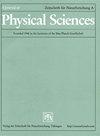Similarity solutions for cylindrical shock wave in a self-gravitating and rotating gas under the influence of monochromatic radiation and azimuthal or axial magnetic field by using Lie invariance method
IF 1.3
4区 物理与天体物理
Q4 CHEMISTRY, PHYSICAL
Zeitschrift Fur Naturforschung Section A-A Journal of Physical Sciences
Pub Date : 2023-09-13
DOI:10.1515/zna-2023-0050
引用次数: 0
Abstract
Abstract The group invariance technique is used to investigate the similarity solution of one-dimensional, unsteady motion of cylindrically symmetric shock waves propagating in a rotating, axisymmetric perfect gas permeated with an azimuthal or axial magnetic field, under the effect of monochromatic radiation, with or without self-gravitational effects. The density is considered to be varying with radiation flux moving through the gas. Considering the absorption coefficient to be variable and choosing different values for the arbitrary constants appearing in infinitesimal generators, all possible cases of similarity solutions with shock paths following the power law and exponential law are discussed in detail, and numerical solutions for both the power law and exponential law path is obtained. The effect of changes in the Alfven–Mach number, density exponent, adiabatic index, gravitational, and rotational parameters on shock formation and shock strength has been obtained for both the power law and the exponential law. Further, the effect of all these parameters on the behaviour of flow variables behind the shock is investigated in detail and the results are depicted graphically via figures. It has been found during the study that, the strength of the shock reduces considerably with an increase in the Alfven–Mach number, rotational parameter and adiabatic index, and it increases with increase in density index and gravitational parameter. Various computations involved in this article are carried out by using the MATLAB software.单色辐射和方位或轴向磁场作用下自重力旋转气体中圆柱形激波的相似解
摘要利用群不变性技术研究了圆柱对称激波在有或无自引力作用的旋转轴对称理想气体中传播的一维非定常运动的相似解。密度被认为随辐射通量在气体中的移动而变化。考虑吸收系数是可变的,并对无穷小发生器中出现的任意常数选择不同的值,详细讨论了幂律和指数律激波路径下所有可能的相似解,得到了幂律和指数律路径下的数值解。得到了幂律和指数律下阿尔芬-马赫数、密度指数、绝热指数、重力和旋转参数的变化对激波形成和激波强度的影响。此外,详细研究了所有这些参数对激波后流动变量行为的影响,并通过图形描述了结果。研究发现,激波强度随着阿尔芬-马赫数、旋转参数和绝热指数的增大而明显减小,而随着密度指数和重力参数的增大而增大。本文所涉及的各种计算都是利用MATLAB软件进行的。
本文章由计算机程序翻译,如有差异,请以英文原文为准。
求助全文
约1分钟内获得全文
求助全文
来源期刊
CiteScore
3.00
自引率
5.60%
发文量
81
审稿时长
3.3 months
期刊介绍:
A Journal of Physical Sciences: Zeitschrift für Naturforschung A (ZNA) is an international scientific journal which publishes original research papers from all areas of experimental and theoretical physics. Authors are encouraged to pay particular attention to a clear exposition of their respective subject, addressing a wide readership. In accordance with the name of our journal, which means “Journal for Natural Sciences”, manuscripts submitted to ZNA should have a tangible connection to actual physical phenomena. In particular, we welcome experiment-oriented contributions.

 求助内容:
求助内容: 应助结果提醒方式:
应助结果提醒方式:


